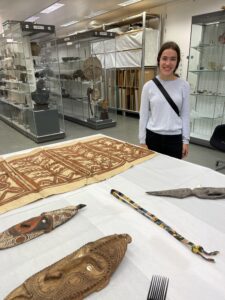Lynne Johnson Travel Award Reflection by Rebekah Lassiter

This summer, the Lynne Johnson Award in the Art Department provided funding for senior art history major Rebekah Lassiter to travel to Hawai’i to continue her study of Oceanic art, its display context and curatorial practice.
My travel through the Lynn Johnson Award has deeply affected the way I perceive art, museums, and presentation and curation techniques, largely as it relates to the visibility of perceptions surrounding indigenous art and the voices that are highlighted to emphasize those experiences. While I may not find myself, ultimately, as a vocational art historian or employed museum curator, the skills, ideas, and notions of diversity and equity will penetrate my every-day actions for years to come. Additionally, the skills and experiences I had will have an immense role in my understanding of scholarly pursuits and archival research. I made life-long memories and learned skills that will last me for a lifetime.
Many interesting and diverse conversations arose, for which I am grateful. For example, when speaking with Samoan community members I was surprised that they emphasized the importance of cultural icons as predominant notions of how their cultural has been influenced. For example, when I spoke to one community member and generally asked him about Samoan art, he felt that contemporary films, such as Disney’s Moana, played a key role in global perception of Pacific culture. I found this interesting as his idea of art was beyond just traditional visual art displays, but extended to films that are publicly available. Further, he noted that much of this information has affected the tourist perception of Pacific culture he has seen while living in Hawai’i. He noted that many tourists expect native island communities to model the Moana-displayed lifestyle and details. However, interestingly, the community member I interviewed stated that the movie is accurate in many ways and so thus is not a terrible representation; however, I find it problematic that global art, and thus one lens or one example of a culture seems to easily set a precedent for cultural stereotypes.
Additionally, I found it eye-opening to gain exposure into some of the less-public aspects of curatorial practice. While meeting with curators, I appreciated the opportunity to receive direct insight from field-experts. For example, while visiting the Bishop Museum in Hawai’i, I met with Dr. Sarah Kuaiwa, and our conversation highlighted issues of transparency and community collaboration that can sometimes be lacking in the art and museum world.
Through this experience, I have grown immensely not only as a scholar, but as a person. Learning how to navigate difficult conversations, with limited transparency, fosters my critical thinking skills. Further, communication in my non-native language, generated an increased sense of independence and confidence that I could only have gained through an experience like this. My sense of self and understanding of the world around me have grown drastically through this experience, and I am unendingly grateful to the art department for this opportunity.
